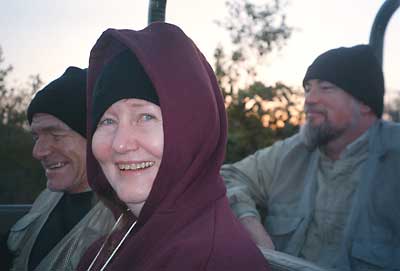
Keeping reasonably warm on the road to Mana
Photo by Pam Bloxham
 Keeping reasonably warm on the road to Mana Photo by Pam Bloxham |
Friday morning was to be our first real game drive, out to Mana Pools (mana means "four" in the Shona language). The best time to see animals is the morning and afternoon, so we had to drag our butts out of bed at 5:30 in the morning to make the three-hour drive north to the waterhole area around the Zambezi River. We set out from camp about 6:30, and it was still quite cold; riding in an open jeep didn't help matters. Those of us who had planned for such eventualities were glad we'd brought warm clothes for the ride. |
| Just a short distance out of camp, our driver stopped, saying he heard some kind of knocking noise. One of the other jeeps pulled up behind us, and after a bit of consultation, they decided the problem was with the brakes, and the solution offered was "try not to use the brakes much." Well, that didn't work very well for long, so we stopped again and all piled out, while the drivers pulled off one of the wheels to examine the brakes. Turned out to be a broken spring, so they just removed it and put everything back together, and we were on our way once more. | 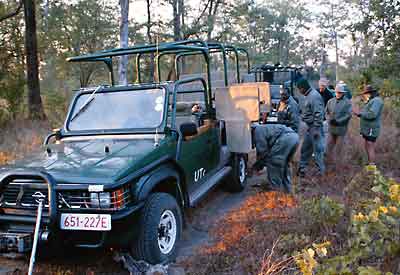 How many safari guides does it take to change a...? This view is what the lions call "the breakfast buffet." |
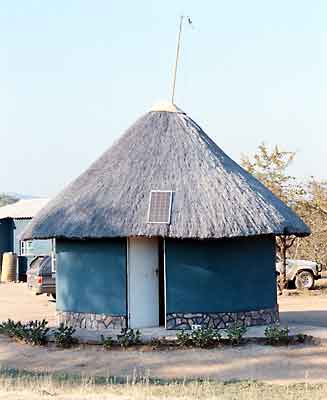 The old and the new: the park ranger's office at the Nyakasikana Gate of Mana Pools has a traditional grass roof with a solar cell mounted on top. |
About three hours later, we finally reached the pools area, and stopped by the side of Long Pool. We got out and hiked a short way through the bush to the waterside...but not too close. One of the guides advised us that a big crocodile could come up out of the water and snatch you from over four meters away before you would even see it. |
And there were crocs, basking on the far shore. And a small pod of hippopotami in the water. Despite their ungainly appearance and the cutesy image people may have gotten from Disney cartoons, hippos are extremely dangerous animals, and are thought to be one of the deadliest animals in Africa. Most experts rate the most dangerous animals in this order: 1) man 2) mosquitoes 3) hippos 4) crocs. We had all present at the waterside, except (probably) for mosquitoes, the weather being too cold for them.
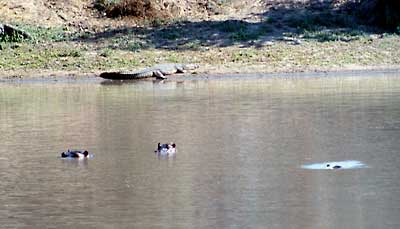 Hippos and a big croc at Long Pool |
Several times, I saw trails of bubbles on the water's surface move towards us, but they would always turn away, or more ominously, vanish. |
Then we headed back to the jeeps and drove around the park for awhile, getting some good (if fairly distant) views of elephants, baboons, impala--lots of impala, waterbucks, zebras, warthogs.
| We stopped for lunch in a large open area by the road, and found the skull of a baboon with a large hole in the top of it. Leopard, the guide said. And then we set out on one of the most dangerous things we did in Africa, a hike on foot. Mana Pools is somewhat different from other wildlife areas in that you are allowed to hike around off the roads if you want. But you take a big risk. When you're in a vehicle, you're relatively safe, because the animals apparently lack the concept of "inside." The vehicle just looks like one big animal to them, so as long as you don't threaten them, they pretty much ignore you. But the guides have a saying: "step out of the vehicle, step into the food chain." We were out of the vehicle. One of the guides knew of a mostly-unknown waterhole a ways off the road, so we set out for that. | 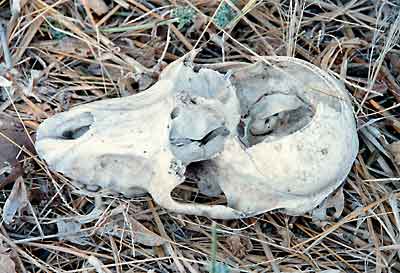 The advantage of staying in the vehicle: a baboon skull with a large, leopard-shaped hole in it. |
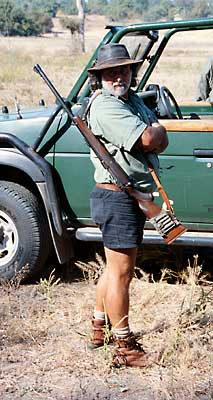 Safari guide Steve shows off his stylish yet practical bush hiking ensemble: cool, loose-fitting shirt and shorts in muted colors, sturdy hiking boots, wide-brimmed hat...and a bloody great elephant gun. |
The guides warned us to stay together, not to make sudden moves, and to not make
too much noise. One of them slung a rifle over his shoulder. Did I say a rifle? Well, it
was actually a little closer to a cannon. It had a barrel you could stick your thumb down,
.458 caliber to be exact, big enough to take down an elephant. Nervous? Nahhhhh, what's
to be nervous about?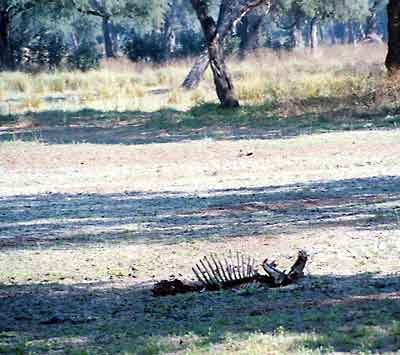 |
So we crept into the bush, making slightly less noise than a herd of charging elephants. Some folks weren't exactly dressed for the trip, either, wearing blues and reds and other colors that stand out just a bit too much when you're trying to stay off the menu. Some were carrying electronic cameras that beeped, buzzed, and generally made all kinds of racket. One of the guides stayed at the rear of the group, making sure that nobody got picked off from behind.
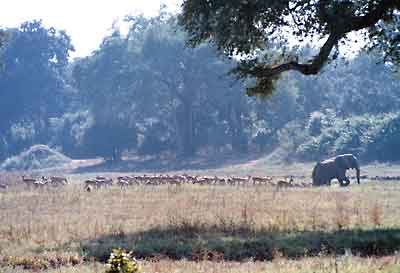 This way, lads! An elephant leads the 11:30 impala parade |
We saw large numbers of baboons, some elephants, waterbucks, the pervasive impalas, but nothing that looked at us like lunch, and nothing very close-up; the animals of Mana Pools are apparently familiar enough with people to know to keep a good distance from them. |
Scenes around Mana Pools: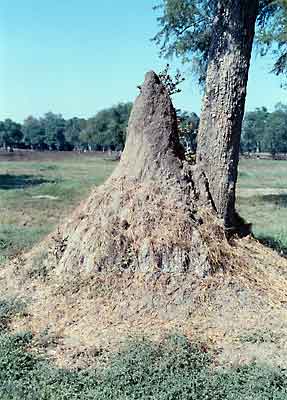 One of the omnipresent termite mounds |
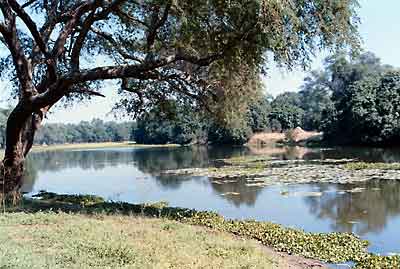 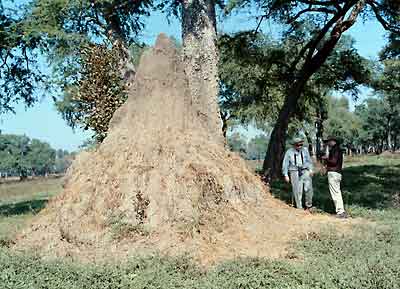 Not a photo trick: this mound really is this big, about 5-6 meters tall. |

| But we all made it back to the jeeps with our full compliment of limbs, and then spent another couple of hours driving around the park. Then, it was another dusty, bumpy three-hour ride back to camp. Along the way, we were told that the road had actually been in worse shape for the last three years or so, and it had just recently been re-graded in preparation for the eclipse tourist influx. | 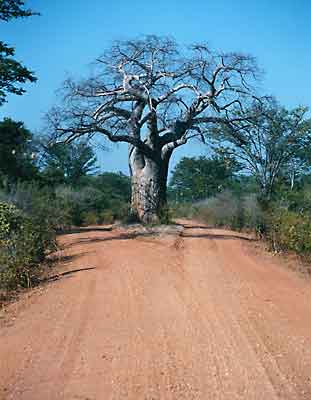 The road back to camp cuts around a baobab |
PAGE: 1 | 2 | 3 | 4 | 5 | 6 | 7 | 8 | 9 | 10 | 11 | 12 | 13 | 14 | 15